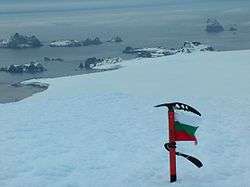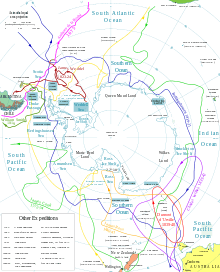William Smith (mariner)
| William Smith | |
|---|---|
| Born | 1790 |
| Died | 1847 |
| Nationality | UK |
| Occupation | ship captain |


William Smith (c. 1790–1847) [1] was the English captain born in Blyth, Northumberland, who discovered the South Shetland Islands, an archipelago off the Graham Land in Antarctica. His discovery was the first ever made south of 60° south latitude, in the present Antarctic Treaty area.
Early life and Apprenticeship
Earsdon Parish Records held at Woodhorn Museum show that William, eldest son of William and Mary Smith, was baptised at St. Cuthbert's Church on 10 October 1790. Smith had a younger brother, Thomas, and sister, Mary, and his father was a Joiner of Seaton Sluice. In the eighteenth century, boys would start their seven-year apprenticeship at sea at the age of fourteen.[2] According to John Miers' account of the discovery, William Smith had undertaken his apprenticeship ‘in the Greenland whale-fishery’.[3] During his life he worked with Richard Siddins, described by historian Ida Lee as "...perhaps the greatest traveler of them all, who gave so much information concerning early Fiji, and delighted to hold mission services on board his ship in Sydney Harbour."
By 1811 he became part owner of a ship called The Williams which was then under construction in Blyth, Northumberland. The vessel was completed in 1813, measuring 215 tons burthen and equipped with six 6-pounder carronades.[4][2]
Discovery of Antarctica
In 1819, while sailing cargo on The Williams from Buenos Aires to Valparaíso, he sailed further south round Cape Horn in an attempt to catch the right winds. On 19 February 1819 he spotted the new land at 62° south latitude and 60° west longitude, but did not land on it. The naval authorities did not believe his discovery, but on a subsequent trip on 16 October he landed on the largest of the islands. He named the island King George Island and the archipelago South Shetland Islands in honour of the Shetland Islands which are to the north of Scotland. At the beginning of the following year, 1820, the Williams was chartered by the Royal Navy, and dispatched with Smith and Lieutenant Edward Bransfield on board to survey the newly discovered islands, discovering also the Antarctic Peninsula in the process.
Honours
Smith Island and Cape Smith in the South Shetland Islands, Antarctica are named after William Smith. [1]
See also
Notes
- 1 2 "Smith Island". SCAR Composite Antarctic Gazetteer. Standing Committee on Antarctic Research. 8 September 1953. Retrieved 22 April 2015.
- 1 2 Jones (1982). Antarctica Observed: Who discovered the Antarctic continent?. Whitby: Caedmon. pp. 59, 62.
- ↑ Miers, John (1820). "Account of the Discovery of New South Shetland, with observations on its importance in a Geographical, Commercial, and Political point of view". Edinburgh Philosophical Journal. 3: 370.
- ↑ Lloyd's Register of Shipping. London: Marchant and Galabin. 1813. p. 753.
Sources
- Antarctic Voyages and Expeditions, retrieved on 2 March 2005
- Glasgow Digital Library: Scotland and the Antarctic: Nineteenth Century, retrieved on 2 March 2005
- Ashgate Publishing: The Discovery of the South Shetland Islands, 1819-1820: The Journal of Midshipman C. W. Poynter, summary of the book retrieved on 2 March 2005